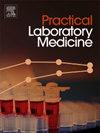SII as a predictor of mortality in patients with non-ST-segment elevation myocardial infarction and diabetes mellitus
IF 1.7
Q3 MEDICAL LABORATORY TECHNOLOGY
引用次数: 0
Abstract
Background
Systemic immune inflammation index (SII) is an innovative marker reflecting immune and inflammatory responses.
Objectives
To explore the predictive value of SII on the risk of death in patients with NSTEMI combined with T2DM.
Methods
An analysis of 448 patients with NSTEMI and T2DM admitted to our institution between December 2017 and May 2022 was conducted in this retrospective study. SII values were used to divide patients into high and low SII groups and investigate their impact on mortality.
Results
According to the analysis results, elevated SII levels are significantly linked to a poor prognosis in patients with NSTEMI and T2DM. Over an average follow-up period of 22.75 months, 106 (23.7 %) all-cause deaths were recorded. The optimal threshold for predicting death was found to be an SII value of 1384.596 × 109/L through ROC curve analysis. Kaplan-Meier analysis indicated that the survival rates were higher in the low SII group compared to the high SII group (P < 0.001). Elevated SII levels were independently linked to increased mortality in patients with NSTEMI and T2DM, according to univariate (HR:3.19, 95 % Cl: 2.18–4.68) and multivariate COX (HR: 2.72, 95 % Cl: 1.81–4.09) regression analyses.
Conclusion
High SII values were strongly associated with mortality in patients with NSTEMI and T2DM. SII serves as a valuable prognostic tool, enhancing the management and prognosis of patients with concurrent NSTEMI and T2DM.
SII作为非st段抬高型心肌梗死和糖尿病患者死亡率的预测因子
系统性免疫炎症指数(SII)是一种反映免疫和炎症反应的创新指标。目的探讨SII对NSTEMI合并T2DM患者死亡风险的预测价值。方法回顾性分析我院2017年12月至2022年5月收治的448例非stemi合并T2DM患者。使用SII值将患者分为高SII组和低SII组,并调查其对死亡率的影响。结果分析结果显示,SII水平升高与NSTEMI合并T2DM患者预后不良显著相关。在平均22.75个月的随访期间,记录了106例(23.7%)全因死亡。通过ROC曲线分析,预测死亡的最佳阈值为SII值为1384.596 × 109/L。Kaplan-Meier分析显示,低SII组的生存率高于高SII组(P <;0.001)。根据单因素(HR:3.19, 95% Cl: 2.18-4.68)和多因素COX (HR: 2.72, 95% Cl: 1.81-4.09)回归分析,SII水平升高与NSTEMI和T2DM患者死亡率增加独立相关。结论高SII值与NSTEMI合并T2DM患者的死亡率密切相关。SII作为一种有价值的预后工具,可以加强NSTEMI合并T2DM患者的管理和预后。
本文章由计算机程序翻译,如有差异,请以英文原文为准。
求助全文
约1分钟内获得全文
求助全文
来源期刊

Practical Laboratory Medicine
Health Professions-Radiological and Ultrasound Technology
CiteScore
3.50
自引率
0.00%
发文量
40
审稿时长
7 weeks
期刊介绍:
Practical Laboratory Medicine is a high-quality, peer-reviewed, international open-access journal publishing original research, new methods and critical evaluations, case reports and short papers in the fields of clinical chemistry and laboratory medicine. The objective of the journal is to provide practical information of immediate relevance to workers in clinical laboratories. The primary scope of the journal covers clinical chemistry, hematology, molecular biology and genetics relevant to laboratory medicine, microbiology, immunology, therapeutic drug monitoring and toxicology, laboratory management and informatics. We welcome papers which describe critical evaluations of biomarkers and their role in the diagnosis and treatment of clinically significant disease, validation of commercial and in-house IVD methods, method comparisons, interference reports, the development of new reagents and reference materials, reference range studies and regulatory compliance reports. Manuscripts describing the development of new methods applicable to laboratory medicine (including point-of-care testing) are particularly encouraged, even if preliminary or small scale.
 求助内容:
求助内容: 应助结果提醒方式:
应助结果提醒方式:


